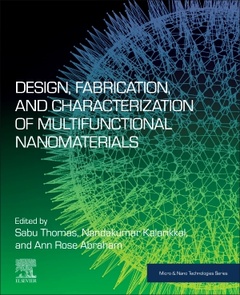Description
Design, Fabrication, and Characterization of Multifunctional Nanomaterials
Micro and Nano Technologies Series
Coordinators: Thomas Sabu, Kalarikkal Nandakumar, Abraham Ann Rose
Language: English
Subjects for Design, Fabrication, and Characterization of...:
606 p. · 19x23.4 cm · Paperback
Description
/li>Contents
/li>Readership
/li>Biography
/li>Comment
/li>
Design, Fabrication, and Characterization of Multifunctional Nanomaterials covers major techniques for the design, synthesis, and development of multifunctional nanomaterials. The chapters highlight the main characterization techniques, including X-ray diffraction, scanning electron microscopy, high-resolution transmission electron microscopy, energy dispersive X-ray spectroscopy, and scanning probe microscopy. The book explores major synthesis methods and functional studies, including:
- Brillouin spectroscopy;
- Temperature-dependent Raman spectroscopic studies;
- Magnetic, ferroelectric, and magneto-electric coupling analysis;
- Organ-on-a-chip methods for testing nanomaterials;
- Magnetron sputtering techniques;
- Pulsed laser deposition techniques;
- Positron annihilation spectroscopy to prove defects in nanomaterials;
- Electroanalytic techniques.
This is an important reference source for materials science students, scientists, and engineers who are looking to increase their understanding of design and fabrication techniques for a range of multifunctional nanomaterials.
Part I. Characterization techniques of nanomaterials 1. State-of-the-art technologies for the development of nanoscale materials2. Temperature-depend?nt Raman spectroscopy for nanostructured materials characterization 3. Brillouin spectroscopy: probing the acoustic vibrations in colloidal nanoparticles 4. In-situ microstructural measurements: coupling mechanical, dielectrical, thermal analysis with Raman spectroscopy for nanocomposites characterization 5. Positron annihilation spectroscopy for defect characterization in nanomaterials 6. The use of organ-on-a-chip methods for testing of nanomaterials 7. Electroanalytical techniques: a tool for nanomaterial characterization 8. Magnetron sputtering for development of nanostructured materials Part II. Design and fabrication of nanomaterials Section A: Development of magnetic nanoparticles 9. Synthesis and characterization of magnetite nanomaterials blended sheet with single-walled carbon nanotubes 10. Magnetic nanocomposite: synthesis, characterization, and applications in heavy metal removal 11. Iron-based functional nanomaterials: synthesis, characterization, and adsorption studies about arsenic removal Section B: Development of perovskite nanomaterials 12. Development of perovskite nanomaterials for energy applications 13. Development of PVDF-based polymer nanocomposites for energy applications 14. Synthesis and structural studies of superconducting perevskite GdBa2Ca3Cu4O10.5+d nanosystems Section C: Development of multiferroic nanoparticles 15. Design of multifunctional magneto-electric particulate nanocomposites by combining piezoelectric and ferrite phases Section D: Green synthesis of nanomaterials 16. Green synthesis of MN (M= Fe, Ni – N= Co) alloy nanoparticles: characterization and application 17. Green synthesis of nanomaterials for photocatalytic application Section E: Development of metal phthalocyanine nanostructures 18. Metal phthalocyanines and their composites with carbon nanostructures for applications in energy generation and storage 19. Fabrication of nanostructures with excellent self-cleaning properties Section F: Development of carbon-based nanoparticles 20. Low-dimensional carbon-based nanomaterials: synthesis and application in polymer nanocomposites Section G: Development of nanofibers 21. Electrospun polymer composites and ceramic nanofibers: synthesis and environmental remediation applications 22. Realization of relaxor PMN-PT thin films using pulsed laser ablation
Dr. Thomas is the Vice-Chancellor and a Professor of Polymer Science and Engineering at Mahatma Gandhi University, India. Additionally, he serves as the Director of the School of Energy Materials at the same institution. Dr. Thomas is internationally recognized for his contributions to polymer science and engineering, covering polymer nanocomposites, elastomers, polymer blends, interpenetrating polymer networks, polymer membranes, green composites, nanocomposites, nanomedicine, and green nanotechnology. His groundbreaking inventions in polymer nanocomposites, polymer blends, green bionanotechnological, and nano-biomedical sciences have significantly contributed to the development of new materials in the automotive, space, housing, and biomedical fields. Dr. Thomas has been conferred with Honoris Causa (DSc) by the University of South Brittany, Lorient, France.
Dr. Nandakumar Kalarikkal is an Associate Professor at the School of Pure and Applied Physics and Joint Director of the International and Inter University Centre for Nanoscience and Nanotechnology of Mahatma Gandhi University, Kottayam, Kerala, India. His research activities involve applications of nanostructured materials, laser plasma, and phase transitions. He is the recipient of research fellowships and associateships from prestigious government organizations such as the Department of Science and Technology and Council of Scientific and Industrial Research of the Government of India. He has active collaborations with national and international scientific institutions in India, South Africa, Slovenia, Canada, France, Germany, Malaysia, Australia, and the United States. He has more than 130 publications in peer-reviewed journals. He also co-edited nine books of scientific interest and co-authored many book chapters.
Ann Rose Abraham, PhD, is currently an Assistant Professor at the Department of Physics, Sacred Heart College (Autonomous), Thevara, Kochi, Kerala, India. Dr. Abraham received M.Sc.
- Explains the major design and fabrication techniques and processes for a range of multifunctional nanomaterials;
- Demonstrates the design and development of magnetic, ferroelectric, multiferroic, and carbon nanomaterials for electronic applications, energy generation, and storage;
- Green synthesis techniques and the development of nanofibers and thin films are also emphasized.




